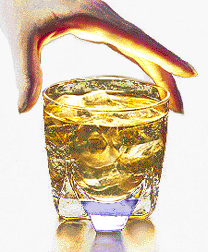


"At NBC, we are very conscious of our obligation to act responsibly in the best interests of our viewers."
Randy Falco
president of the NBC Television Network.
For nearly fifty years the major television networks have adhered to a
voluntary ban on hard liquor advertising. That's over.
liquor advertising. That's over.
General Electric's NBC has entered a multi-million dollar contract with
Guinness-UDV whose alcohol brands include: Tanqueray gin, Johnnie Walker scotch, Smirnoff Vodka, and Smirnoff Ice. NBC's decision to break their voluntary ban and air the liquor ads will
have a negative impact on the problems of substance abuse, increase the
amount of alcohol advertising and pressure to drink to which the public is
exposed. In the spirit of keeping up with the Joneses, it is possible the
other major networks will follow NBC's lead.
Alcohol is a contributing factor to violence and many injuries, including
traffic crashes, burns, drownings, and other injuries. These injuries,
health problems, and deaths cost our society a great deal, financially and
emotionally. The Trauma Foundation firmly believes that keeping liquor
advertising off of television is an important component for preventing
alcohol-related injuries and violence.
What You Can Do!
If you are concerned about NBC's decision, you are not alone. In a recent
survey, 68 percent of respondents opposed NBC's action; 70 percent of
Americans agreed that it is dangerous to have liquor ads on TV because they
will introduce young people under the legal drinking age to liquor. (CSPI
www.cspinet.org)
Write to CBS, ABC, FOX, and WB to congratulate them on their commitment to
voluntarily banning hard liquor advertisements. And write to NBC and express
your disappointment and outrage about their decision to air hard liquor ads
on their network. Feel free to make use of the information and statistics
below to include in your letters.
What's the Big Deal?
The alcohol beverage industry currently spends more than a billion dollars
annually promoting drinking in well orchestrated marketing, with full
understanding of the importance of how their products must be priced, placed
and promoted. They understand that their products must be specifically
designed for various segments of our society. They know their market, and
they know what strategies increase their market.
The decision to market hard liquor on television may well be the harbinger
of an array of new alcoholic products designed to be marketed in new,
aggressive ways to specific segments of our society, including those who
might not respond to beer ads. For example, women probably are a market
viewed as unsaturated by the alcohol industry.
You can be sure they know their best customers are heavy drinkers -- those
approximately eleven percent who drink about two-thirds of the alcohol
produced in the U.S. The alcohol industry is quite aware that the heaviest
drinking segment of our society is men between 18 and 30 years of age.
(Moore and Gerstein, D.R. eds. Alcohol and Public Policy: Beyond the
Shadow of Prohibition. National Academy Press, 1981; p. 27.) The
new television ads will certainly target this segment of the population as
well, with their full arsenal of sex, power, and success fantasies linked to
drinking.
What's Wrong with this Picture?
Youth drink alcohol, including hard liquor, and experience substance
abuse problems. 80 percent of high school seniors have used alcohol. (2000
Monitoring the Future Study) and 75 percent of 11th graders report
drinking alcohol in the past six months.
Underage drinkers are consuming beer, wine, and hard liquor. Between 2000
and 2001, more than 62 percent of 12th grade students reported using beer on
an annual basis, 54 percent reported using wine coolers, and 62 percent
reported drinking liquor. In the same period, more than 40 percent of 12th
graders reported using beer monthly, 25 percent used wine coolers
monthly, and 37 percent drank liquor on a monthly basis. (Parents
Resource Institute for Drug Education/ PRIDE 2001)
According to the most recent Treatment Episode Data Set (TEDS) Report from
the Substance Abuse and Mental Health Services Administration (SAMHSA), the
number of adolescents aged 12 to 17 admitted to addiction treatment has
increased 20 percent between 1994 and 1999, of which a staggering 47 percent
were due to alcohol abuse.
The total cost of alcohol abuse by youth--including traffic crashes, violent
crime, burns, drowning, suicide attempts, fetal alcohol syndrome, alcohol
poisonings and treatment--is more than $58 billion per year, equivalent to
more than $200 for every man, woman, and child in the country. (Pacific
Institute for Research and Evaluation in support of the Office of
Juvenile Justice and Delinquency Prevention, Enforcing the Underage Drinking
Laws Program (1999).
People who begin drinking before age 15 are four times more likely to
develop alcoholism than those who begin at 21. (Hawkins and
Catalano. "Risk and Protective Factors for Alcohol and Other Drug
Problems in Adolescence and Early Adulthood: Implications for Substance
Abuse Prevention, 1989.)
The alcohol industry targets youth and profits from youth consumption. The
alcohol industry uses images that appeal to children and young people.
Marketing messages by beer manufacturers use images and messages that are
highly attractive to young people. Research has shown that children as young as
fourth and fifth grades were able to identify animal characters with a
specific beer brand. (Leiber. "Commercial and Character
Slogan Recall by Children Aged 9-11 Years: Budweiser versus Bugs Bunny"
Center on Alcohol Advertising, Trauma Foundation, 1996.)
Youth consumption of alcohol accounts for approximately 10 percent of all
alcohol sales, according to a survey conducted by the National Clearinghouse
for Alcohol and Drug Information.
The alcohol industry acknowledges measured advertising (advertising in
print, on TV, radio, and outdoor ads) expenditures of more than $1.3 billion
in 2000 (Impact Data Bank 2001), but the Federal Trade
Commission (FTC) estimates the actual total, including unmeasured
advertising, as triple that amount.
NBC's decision to break its voluntary ban on liquor ads on television is
a bad decision. It is not too late to voice your opinion. And it still is
not too late for NBC to do the right thing.
For more information, please see Community Anti-Drug Coalitions of America (www.CADCA.org) and The Center for Science in the Public Interest
(www.cspinet.org)
01-28-02
 |
 |
|---|